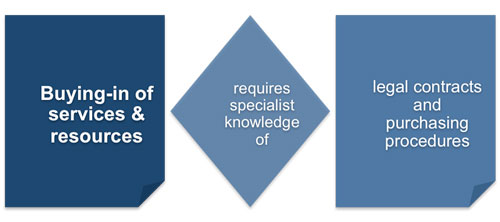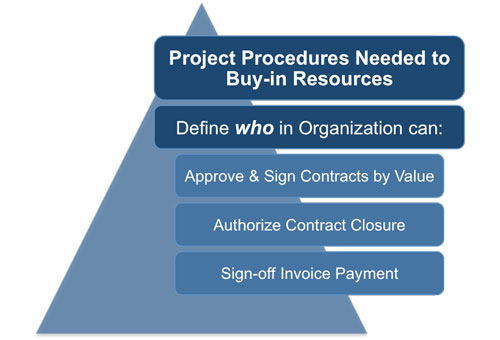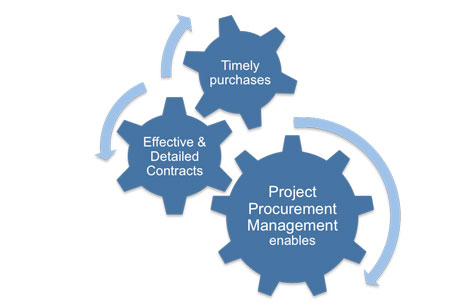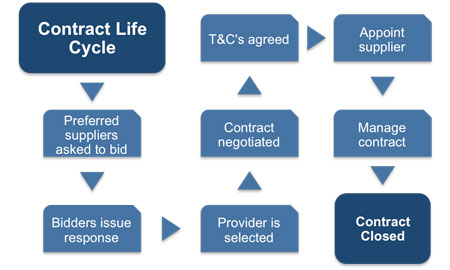Managing Project Suppliers
Many projects will require some external resources, services or products to be able to meet their objective. Those that cannot be provided internally will need to be purchased from an external source. The more complex a project is the more likelihood it will need outside specialists to meet its objective.
Outsourcing has become one of the most popular and efficient ways to procure these additional and specialist resources. The nature of traditional fixed price contracts is not always suitable to the project environment where creative input from suppliers and partners is required as the contract scope evolves.
 |
Buying-in services, products and resources involves the need for legal contracts and each organization will have their own policies and procedures that must be followed when making any purchases on their behalf. Such specialist knowledge often requires a person ('the customer') to be included on the project team.
Projects can rarely be resourced completely from internal expertise and personnel, so external resources need to found. Once the requirements have been defined, suppliers are invited to bid for the work and from these responses a supplier must be chosen to provide the service, product or result.
Throughout this process, the project manager will call upon experts in the purchasing department to assist and were necessary assigned to the project team. Decisions as whether to outsource and whom are made by the relevant stakeholders with the assistance of the project manager.
 |
When dealing with suppliers, there will inevitably be a legally binding contract involved that represents a mutually binding agreement. This obligates the supplier to provide the specified products, services, or results, and obligates the customer to provide payment in return.
These contractual obligations are the way in which risks the project faces can be alleviated or transferred to the provider. Knowing how to identify, assess and minimize risks is covered in our 'Project Risk Management' eBook.
The legally binding nature of a contract means that it needs to be subjected to an approval process. This ensures that it not only describes the products, services, or results that will satisfy the identified project need but that it complies with organizational procurement policies.
Most organizations will have documented policies and procedures describing who has authority to sign and administer such agreements on behalf of the organization. In addition, the project management team may be required to take advice from the organization's legal representatives.
 |
All contracts have a lifecycle in which the supplier is first viewed as a bidder, then as the selected provider, and finally as the contracted supplier. By actively managing this lifecycle and carefully wording the terms and conditions of the contract, some identifiable project risks can be avoided, mitigated, or transferred to the supplier.
This website discusses procurement in terms of a customer/supplier relationship where the customer is part of the project management team and the supplier is an external organization. However, most of the information is equally applicable to non-contractual work, entered into with other departments within the performing organization.
In order to keep things simple, it refers to the parties involved in procurement as the customer and the seller/supplier. The customer is the party who are purchasing or procuring the goods or services, the seller or supplier is the party that provides or delivers the products or services to the customer. This is the case even where no money is involved or where the parties are part of the same performing organization.
 |
Contract management processes should ensure that you retain control of any project purchases and that they are timely with effective and detailed contracts. They also enable you to create a good working relationship with the organization's customers gaining first-hand knowledge of their skills, expertise and abilities.
A key role for the project manager is liaising with and getting a final decision from the relevant stakeholder(s) for each project purchase. You must have a clear understanding of the risks associated with each purchase and the other options available to you.
 |
Getting the necessary contacts signed is only part of your responsibility. Once this has been completed you use the contracts, service level agreements (SLA's) plus their terms and conditions to monitor and manage the service, product or resource supplied. Your final responsibility is to ensure properly closure is brought to each contract protecting the legal interests of all parties.
Day-to-day purchases should be left to the procurement department. Your role as project manager is to ensure that sufficient time is planned and scheduled for these processes.
You may also be interested in:
Managing Project Costs | Estimating Project Costs | Calculating the Total Project Budget | Monitoring Project Expenditure | Buying-in Goods and Services | Managing Project Suppliers | Planning Contract Management | Understanding Different Contract Options | Managing Supplier Relationships.
|
|

